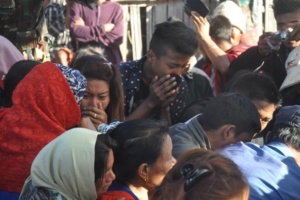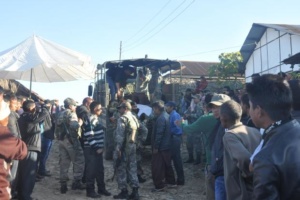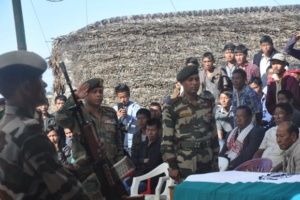There was a time when tribes in Nagaland used to go to war against each other. All that ended once Christianity made its way into the state. With the rise of underground rebel groups, today, Nagaland is reliving those days from the past.

First published:
https://www.livemint.com/Sundayapp/dWYlUB1TpluEydUyKBelRP/When-a-Naga-kills-a-Naga-Of-strife-and-tragedy-in-the-North.html
Of strife and tragedy in the
North-East
With no end to the conflict between the army and the rebels in sight, a tiny village in Nagaland mourns one of its own
The sleepy village of Shiyong was abuzz on Sunday. Conversations over a session of rice beer revolved around one topic—the attack on an Assam Rifles convoy in Arunachal Pradesh on 2 December.
While there are conflicting reports on the number of soldiers killed in the ambush orchestrated by Naga rebels from the Khaplang faction of the National Socialist Council of Nagaland, or NSCN(K), this was about one person—Nanwang S. Konyak, a resident of Shiyong who joined the force just four years ago.
The 29-year-old’s body arrived on Monday, when the locals usually go about their business in the fields and the tea plantations that dot the hillside, but on this day, Shiyong came to a standstill. It was a first in modern times for the village—a Naga had killed a Naga.

From noon onwards, an entourage of bikes sporting black flags piled up at the village gate alongside a convoy of the Assam Rifles from the village of Wakching, located on a neighbouring hill. The discussions were around the prevalent situation in the north-east.
This was the third attack on an army convoy in the region in two weeks—a situation that the locals are all too familiar with. Only this time, it was one of their own who had sacrificed his life.
Shiyong, in Nagaland’s Mon district, is home to the Konyak tribe—one of the fiercest warrior clans, once famous for their practice of headhunting.
During World War I, the British recruited Naga tribesmen for their fearlessness. Jonathan Glancey writes in his book, Nagaland: A Journey to India’s Forgotten Frontier: “German troops who occasionally came up against Naga warriors in the trenches during the First World War were shocked to have to fight ‘savages’. They thought this demeaning and complained to their High Command. What worried them most, though, was the fact that Nagas saw war in the trenches, no matter how alien, as an opportunity for headhunting on an epic scale. In the event they agreed to bring back the spiked helmets of their victims rather than their severed heads.”
While the practice of headhunting has long been discontinued, the warrior culture isn’t dead—for years now, the Konyaks have been recruited as part of the army and the Nagaland Police. About 14 from Shiyong are currently serving in some of these institutions, not to mention a number who have retired. Most, however, don’t remember there every being a casualty from the village, which made Nanwang’s loss all the more emotional.
The eldest of seven siblings, Nanwang had joined the Assam Rifles four years ago. He did not have a flamboyant personality, but he was known for his hard work on duty, remembers a member of his unit from the 16 Assam Rifles who had come to attend the funeral.
He had been stationed in Tirap district, Arunachal Pradesh; while on patrol, their convoy of two vehicles was attacked just outside the village of Disa, some 20-odd km from the India-Myanmar border. A barrage of bullets rained down on Nanwang’s vehicle, and he fought back to the best of his abilities.
“Even if it was a simple chore, if it was left to Nanwang, you knew that it would be done well,” says the unit member, who declined to be named.
He added that Nanwang’s vehicle was completely destroyed by the end of the attack. His helmet had blocked four bullets, but one got through and he died in the hospital later that evening.
One of the villagers said that Nanwang was a blood relative to the second-in-command at NSCN(K), which added to the agony of the situation. He added that the government had of late deployed mostly local boys in camps close to the border, which has not gone down well with communities in the north-east.
As the first of the escort vehicles arrived from the town of Mon, the cavalcade started off. The locals led the procession, followed by the vehicle bearing Nanwang’s remains and trucks carrying Assam Rifles personnel. They drove all the way to the end of the main road in Shiyong, as villagers thronged the sides and followed.
The coffin wrapped in the Indian flag was offloaded at the Ahngpan Morung, which housed young Konyaks back in the day as they readied for battle. It was the same place they brought back their dead, along with the heads hunted during the fight.

The entire village mourned the loss alongside Nanwang’s family. Youngsters fired shots into the air in homage; the following day, the Assam Rifles unit did the same. Prayers were said for the departed soul, who was later buried on a slope below the Morung.
***
Groups demanding nationhood for Nagaland have been around for years. The fight was led by Angami Zapu Phizo after Independence, and is today continued by various underground groups.
While most of the other rebel factions have either surrendered or declared a ceasefire with the Indian government, the NSCN(K), which claimed responsibility for the attack, remains active. The faction is camped in Myanmar and conducts strikes time and again, chasing the dream of an independent Nagaland.
Among the villagers in Shiyong though, there seems to be little enthusiasm for such a dream. A local schoolteacher believes that Nagaland cannot stand on its own as there are not enough resources within the state, as a result of which they bank on India for the basics.
“The rice we grow here is good for four months—the rest of the time, we go to the local shops to get our supply. This extends to a lot of other essential items. How does this demand for independence make sense?” he asks.
The rebel groups depend on local Naga communities for supplies; another villager says that they have little choice but to comply—resisting would simply lead to more trouble.
***
There is a craze for guns in these parts, which started when the first armed British explorers arrived. The Konyaks were quick to learn the mechanism, and soon started making their own guns. Travelling around Mon district, it’s hard to miss the single-barrelled rifles slung across the shoulders of many of the locals.
The same love for arms continues to these days among the youngsters—the army, then, becomes an obvious choice for many.
Those joining forces with the rebel groups come from underprivileged backgrounds, with little access to education or a livelihood, said a teacher in Shiyong. Some are even army aspirants, who failed to make the cut during their stringent recruitment drives, and some are shown dreams of an easy life, once independence is attained, he added.
“This belief that all will be well if their demands are met draws a lot of youth, who have little idea of the consequences. They dread the migrant, jungle life, but are sold to the ideology. The educated ones know that this isn’t the solution,” says one villager.
The army camps situated in strategic locations provide help to the villagers time and again, claims one officer, who also declined to be named. From organizing football tournaments for the youth to helping the locals with basic resources such as water, it’s their way of showing support, he says.
“It’s the villagers who have to stand up against these rebel groups to deny them basic necessities. These Konyaks are a warrior race after all, who can defend themselves when needed,” says an army officer.
“What is happening is the result of a failed state government, who have not been able to create employment opportunities for the Nagas. This community now realizes that this fight is pointless, and wants to progress just like anywhere else in India,” he adds.
But the truth remains—and the officer cleverly brushes aside the query—that there is little security for the Naga villages, including those who have laid down their arms to lead a normal life. While the government offers help with jobs and farming, there is no line of defence when the rebel groups decide to pay a visit.
***
In the old days, when a tribesman’s status as a warrior depended on the number of heads he had, a Naga would attack another Naga for reasons ranging from social to spiritual, and sometimes simply as a matter of survival. But the internecine violence of the present day leaves many wondering whether there’s any point.
Accusations fly fast and thick, including some against the Indian government and those that call Nagaland a “disturbed state”. But at the end of the day, one wonders exactly why Nanwang had sacrificed his life.
A ceasefire may be the best answer for now, given that a long-term solution is hard to define and envision. All parties could to sit at a table and figure out a solution that is best suited for Nagaland.
Until then, a Naga may still fall to another Naga.